“Spirit & Attitude”
George Leonard Scott III was a film aficionado who intended to pursue a career in that field, but his eventual segue into music forged a different legacy for the Midwestern youth. Born in Burlington, Iowa, on Oct. 16, 1953, he resettled with his family in Florida in the late 1960s. He attended his last three academic years at Sarasota High School (where one of his classmates was none other than Paul Rubenfeld, who would later change his name to Paul Reubens, eventually becoming best known as Pee Wee Herman).
One of Scott’s high school buddies recalled the first time he encountered his soon-to-be friend in a tenth grade chorus class: “George, who had a crew cut back then, came into class and sat down next to a senior who immediately tore off George’s ‘George Wallace for President’ button, threw it on the floor and stomped on it. The latter-day George would’ve kicked his ass, but the newcomer from Iowa was very quiet.”
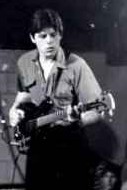
George Scott live with 8-Eyed Spy, 1980
After graduating high school, Scott attended college for a year. Bored with Florida living and interested in left wing politics, he decided to move to New York. At this point in time, Scott’s decision didn’t have anything to do with pursuing music, since he hadn’t started playing an instrument yet. This would soon change, though, as he took to reading various music magazines, like Bomp, Time Barrier Express and Trouser Press, and listening to records that belonged to a friend of his. It wasn’t long before Scott became infected with the musical virus.
He soon became aware of a burgeoning music scene that was sweeping the city. The New York Dolls were near the end of their run, but bands like Television and the Patti Smith Group were sprouting up. This new movement inspired Scott to take the plunge, and he soon bought a cheap bass at a pawn shop.
Scott eventually joined Jack Ruby, a band consisting of Robin “Robby” Hall (vocals), Chris Gray (guitar), and a succession of drummers. This musical union would eventually have a tragic result – one of Scott’s band mates introduced the bass player to heroin sometime in 1977. Some sources implied that Scott’s descent into the narcotic subculture may have been forthcoming regardless of his band mate’s influence, given his interest in songs like the Velvet Underground’s “Heroin” and “Waiting for My Man.”
By early 1978, Jack Ruby had dissolved and Scott joined James Chance in the Contortions. In a 2003 interview, Chance claimed that Scott “was strictly a rock bass player, and not that accomplished. I basically taught him his parts note by note, as he never played any funky bass before he joined the Contortions.” Don Christensen, however, gave his cohort more credit than that, claiming that although Chance showed Scott what he basically wanted him to play, that Scott would “interpret” the lines as he saw fit, putting his personal stamp on it. “We weren’t sidemen,” Christensen stressed. “We were definitely a band.”
In any event, his time with Chance didn’t really show George Scott at his professional best. Nevertheless, Scott stuck it out for about a year before leaving to pursue other interests. He jumped at the chance to tour with John Cale, producing sessions that resulted in the live Sabotage! album. Another project was 8-Eyed Spy; Scott recruited Pat Irwin and Michael Paumgarden for the new undertaking, and Lydia Lunch brought in Jim Sclavunos. The band “played a bunch of shows around New York and . . . started to make a little noise,” Irwin reflected. “I think we had even done a couple of small trips out of town and played a few shows around the country. 8-Eyed Spy wasn’t together that long, but long enough. Lydia liked to move fast and if I’m not mistaken she was getting kind of tired of it after this first bit of touring although we kept it together for a while. Lydia kind of wanted to pull things back; the rest of the band wanted to plow ahead.”
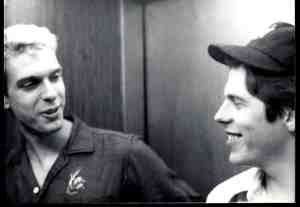
Jim Sclavunos and George Scott, 1980
Scott’s musical influences were many and widespread: He liked vocal groups like the Beach Boys, the Four Seasons, and Vito and the Salutations, pop/rock bands like the Beatles and the Rolling Stones, and the more off-the-wall stuff like Captain Beefheart. But, perhaps more than anything else, he had an affinity for instrumentals: he liked Dick Dale, Jack Nitzsche, the Ventures, and Link Wray in particular.
According to Irwin, it wasn’t uncommon for a musician to have several projects going at once, as opposed to being just dedicated to one band, so it wasn’t any wonder that Scott hatched a plan to form an instrumental combo while still working with 8-Eyed Spy. During the fall of 1979, Scott brought together the original Raybeats: Jody Harris (guitar), Don Christensen (drums), Pat Irwin (guitar, saxophone, organ) and himself on bass.
Oddly, Scott’s fellow Raybeats, Christensen and Irwin, couldn’t think of any specific bass-playing influences that he may have had. As Pat Irwin put it, “George was more influenced by spirit and attitude.” However, Jesse Sublett, bassist/vocalist for the Texas-based punk band The Skunks, who would crash at George’s apartment when he was in NYC, did remember some conversations they had about musical influences.
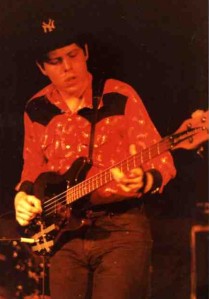
George Scott, live with 8-Eyed Spy, 1980
Sublett concurred with Irwin’s interpretation of Scott’s “spirit and attitude,” claiming, “he was not the typical or stereotypical, even clichéd musician dweeb who goes on and on about gear and influences, etc. But, we did talk about stuff like that because I tend to talk about stuff like that. He was not disinterested in craft, influences, and the tools of the trade.”
Obvious influences on Scott’s style included John Cale (Velvet Underground) and Dave Alexander (Stooges). Others who came up in conversation were John Entwistle (The Who), Jack Bruce (Cream) and Willie Weeks (who worked with a host of big name musicians, including George Harrison and Ron Wood). And Pat Irwin did remember that Scott had a poster of Bootsy Collins hanging on his apartment wall.
“I know it may sound immodest,” Sublett said, “but we greatly admired each other’s playing. We both had a very up-front sound and I was exceedingly loud.”
Everyone who got to know Scott to any degree recognized his enthusiasm for music. He had “tons of records . . . nearly all 45s,” Sublett stated. “He loved obscure punk and rockabilly but also lots of surf and Phil Spector, and we were both huge ABBA fans. And he turned us on to Fred Blassie, too.” (Blassie was a professional wrestler, popular in the 1950s and ‘60s, who scored a cult hit with the song “Pencil Neck Geek.”)
“A night out with George was something else,” Irwin recalled. “He had the most amazing record collection and he loved to play 45s until sunrise – he loved to play them loud. George loved to get summonses from the police for excessive noise. He would post all [of] the summonses up on his apartment wall. It got [to be] like wall paper.”
Michael J. Weldon, founder of Psychotronic Video magazine, was another Midwestern transplant hanging out on the fringes of the NYC club scene. He and Scott knew some of the same people, like the late Bradley Fields, the late Peter Laughner, Adele Bertei, Anton Fier and Charlie Beesley. Beate Nilsen, a girlfriend of Scott’s, lived in the same apartment building that Weldon did; Scott and Weldon struck up a short-lived friendship.
“He visited me in my apartment a few times,” Weldon remembered, “most likely on days he was also visiting Beate upstairs. He was passionate about instrumental music above all and gave me cassette tapes of rare Link Wray and Freddie Cannon 45s and B-sides. I still have them.”
Besides having acquaintances in common, Scott and Weldon had both worked at Bleeker Bob’s, a record store, though at different times. “It was, by far, the worst job I ever had,” Weldon recalled. “‘Bleeker’ Bob said that George – and several other former employees who were in bands – had stolen most of their record collections from his store. Could be.”
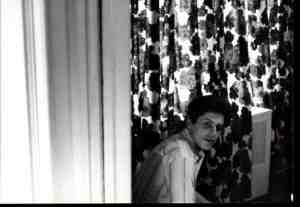
George Scott in an Atlanta hotel room while on tour with 8-Eyed Spy
Scott’s apartment was located approximately half a block from CBGB’s, which made it convenient for the musical crowd. According to Sublett’s description (in his autobiography), “[It] was on the fifth floor, a classic 19th century immigrant’s dump, with the bathtub in the kitchen and one window facing the street.” He would often put up out-of-town musicians in his apartment so they could save on expenses.
As the summer of 1980 got underway, things in Scott’s life seemed to be taking a bleak turn. According to Christensen, it was “a dark time.” Scott was having difficulties where romantic relationships were concerned, and some of his musical endeavors weren’t going as well as hoped, either. But, he was enthusiastic about what the Raybeats were accomplishing, and Christensen doubts Scott’s death (on August 5th, 1980) was intentional.
“At the time, there was a rash of heroin overdoses around New York City,” Christensen recalled. “Apparently, some extra strong stuff hit the market that summer, and George was one of those who fell victim to it.”
There’s also the possibility that, according to some sources, Scott was only an occasional user of the drug, so his death could have been attributed in part to his inexperience in handling it.
Scott’s body was shipped back to Iowa for burial.
“It was a shock when I heard from Beate that he had died, but he was one of too many,” Weldon said. “People were starting to die like flies in NYC at the time. I later had a similar, if a bit longer, friendship with Lester Bangs. I nearly lost count of the number of people who had sat on my old couch in the ‘80s that died.”
Although the Raybeats continued following Scott’s death, recruiting Danny Amis (and subsequent bass players), recording one EP and two LPs and touring a respectable chunk of the globe, it proved to be a blow the band never fully recovered from.
“I really enjoyed playing with some of the other bass players, like David Hofstra and Bobby Albertson – and Danny, God bless him, stepped up to the plate when we really needed him,” Christensen said. “But, when George died, I lost a close friend and a great collaborator, and it was never as good without him.”
Pat Irwin shared Christensen’s view, an unsurprising one since Scott was “the pivotal member” of the band, the one man who got it all rolling in the first place.
“No George, no Raybeats,” Irwin succinctly stated. “There isn’t a day that goes by when I don’t think about George. He was a real spirit and really drove the band.”
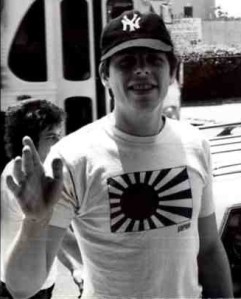
George Scott outside the Georgian Terrace while on tour with 8-Eyed Spy
Sources
Christensen, Don. Telephone interviews. August – September 2005.
Irwin, Pat. Personal e-mails. 8 Feb 2004, 24 Mar 2004, 25 Mar 2004
Sublett, Jesse. Never the Same Again: A Rock ‘n’ Roll Gothic. Berkeley, CA: Boaz Publ. Co., 2004.
Sublett, Jesse. Personal e-mails. 12 Feb 2006, 13 Feb 2006
Weldon, Michael J. Personal e-mails. 25 Feb 2004, 24 Mar 2004.
LINKS: